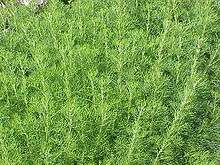Artemisia abrotanum
Artemisia abrotanum, the southernwood, lad's love, or southern wormwood, is a species of flowering plants in the sunflower family. It is native to Eurasia[2] and Africa but naturalized in scattered locations in North America.[3][4] Other common names include: old man, boy's love, oldman wormwood, lover's plant, appleringie, garderobe, Our Lord's wood, maid's ruin, garden sagebrush, European sage, sitherwood and lemon plant.
| Artemisia abrotanum | |
|---|---|
 | |
| Scientific classification | |
| Kingdom: | Plantae |
| Clade: | Tracheophytes |
| Clade: | Angiosperms |
| Clade: | Eudicots |
| Clade: | Asterids |
| Order: | Asterales |
| Family: | Asteraceae |
| Genus: | Artemisia |
| Species: | A. abrotanum |
| Binomial name | |
| Artemisia abrotanum L. 1753 not Thunb. 1784 | |
| Synonyms[1] | |
| |
Southernwood has a strong camphor-like odour and was historically used as an air freshener or strewing herb. It forms a small bushy shrub, which is widely cultivated by gardeners. The grey-green leaves are small, narrow and feathery. The small flowers are yellow. It can easily be propagated by cuttings, or by division of the roots.
This plant has gained the Royal Horticultural Society's Award of Garden Merit.[5]
Uses
A yellow dye can be extracted from the branches of the plant, for use with wool. Its dried leaves are used to keep moths away from wardrobes. The volatile oil in the leaves is responsible for the strong, sharp, scent which repels moths and other insects. It was customary to lay sprays of the herb amongst clothes, or hang them in closets, and this is the origin of one of the southernwood's French names, "garderobe" ("clothes-preserver"). Judges carried posies of southernwood and rue to protect themselves from prisoners' contagious diseases, and some church-goers relied on the herb's sharp scent to keep them awake during long sermons.[6]
The pungent, scented leaves and flowers are used in herbal teas. Young shoots were used to flavor pastries and puddings. In Italy, it is used as a culinary herb.
In the traditional medicine of East and North Bosnia and Herzegovina, aerial parts of Artemisia abrotanum are used in jaundice therapy.[7]
A poem by Edward Thomas (1878 - 1917) concerns the herb: Old Man or Lad's Love
References
- "The Plant List: A Working List of all Plant Species".
- Altervista Flora Italiana, Abrotano, Artemisia abrotanum L. includes photos + European distribution map
- Flora of North America Vol. 19, 20 and 21 Page 522 Southernwood, lad’s love, old man, armoise aurone Artemisia abrotanum Linnaeus, Sp. Pl. 2: 845. 1753.
- http://bonap.net/MapGallery/County/Artemisia%20abrotanum.png
- "RHS Plant Selector Artemisia abrotanum AGM / RHS Gardening". Apps.rhs.org.uk. Retrieved 2012-11-07.
- Alice Morse Earle (1851-1911), The Sabbath in Puritan New England, chapter 4.
- Tewari D, Mocan A, Parvanov ED, Sah AN, Nabavi SM, Huminiecki L, Ma ZF, Lee YY, Horbańczuk JO, Atanasov AG. Ethnopharmacological Approaches for Therapy of Jaundice: Part I. Front Pharmacol. 2017, Aug 15;8:518. doi: 10.3389/fphar.2017.00518.
External links
| Wikimedia Commons has media related to Southernwood. |
- Southernwood Spice Page by G. Katzer